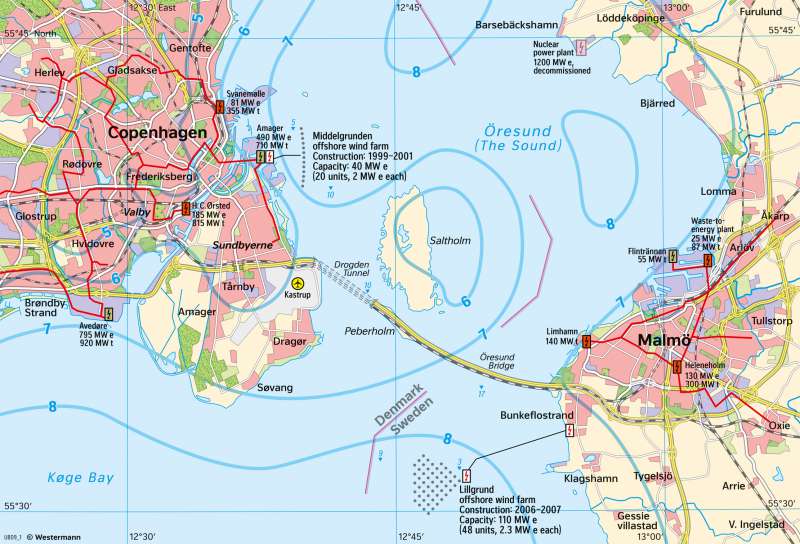Öresund - Offshore wind farms and district heating
Energy
978-3-14-100890-6 | Page 75 | Ill. 4

Overview
The Sound or Öresund/Øresund connects the Baltic Sea to the Kattegat. Here, two major offshore wind farms produce energy for the Danish and the Swedish grid.
Middelgrunden
Between 1999 and 2001, the Middelgrunden wind farm was built east of Copenhagen. With its 20 wind turbines with a capacity of two megawatts, this was once the world's largest offshore wind farm. With a total capacity of 40 megawatts, it produces 89 gigawatt hours of electricity, equivalent to three percent of the energy consumption of Copenhagen. The 20 wind turbines are each placed at a distance of 180 metres and form a slight curve with a length of 3.4 kilometres. The wheel hubs are located at a height of 64 metres and the wings have a diameter of 76 metres. Each wind turbine can operate independently from the others. The generated electricity is routed to the power plant in Amager.
The wind farm was built as collaboration between the Middelgrunden Wind Turbine Co-operative and Copenhagen Energy, which have built ten wind turbines. The entire project is managed by the SEAS Wind Energy Centre. Everyone involved in the construction firms were Danish.
The construction of wind farms was preceded by extensive studies. The present site was finally selected, and since the 1980's, was filled with rubble in its location off the port of Copenhagen, making the present water depth only two to six metres. In 1997 and 1998, two public hearings were held. After the first hearing, the original number of wind turbines of 27 was reduced to 20. In May 1999, the project received planning permission. Two years later, the wind farm was opened.
Øresund Bridge
Since 2000, the Øresund connection has run between Copenhagen and Malmö, Sweden. The 16-kilometre road and railway connection consist of a tunnel, artificial island (Peberholm) and a 1092-metre-long cable-stayed bridge, which is supported by two 204 metres high pylons. Many passengers cross the bridge every day by car or train. Freight trains also use the connection to transport cargo from one country to the other.
Lillgrund
Six kilometres south of the Öresund Bridge, lies Lillgrund, the Swedish offshore wind farm. The wind farm was built between 2006 and 2007 and includes 48 wind turbines with a capacity of 2.3 megawatts each. The wind farm is operated by Swedish utility company Vattenfall. An offshore substation combines the generated power, and a power transformer enables the supply to the Swedish grid. The total installed capacity of 110 megawatts is enough to supply about 60,000 Swedish households. Both the wind turbines, as well as the infrastructure for the grid connection, were built by Siemens Energy.
Both countries use coal, gas or biomass in heat and power plants to further generate energy. The energy is then distributed via the main district heating tunnels.
The graph on the bottom shows the varying electricity supply Denmark's power plants can generate. Depending on the wind and thus amount of electricity the wind farms can supply during a day, the country needs to import electricity to meet the demand. On other days, Denmark even produces enough electricity to export because of surpluses.




